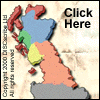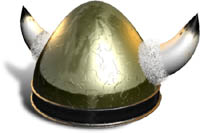
|
The Decline of the Pictish Kingdom of Caledonia
What the Picts called their country before first contact is unknown, but the Pictish people are probably best represented by the title Cruithni, a name given by the Irish and generally applied to all tribes in the area. In history, however, these people are better known by the name the Romans gave the country of the feared tribes, Caledonia, and the Caledonian people themselves as the Pictii or 'painted ones' - in reference to their blue body paint.
Around the later part of the first century, a loose confederation of the seven tribes that lived in what we now call Scotland appeared on the scene. This confederation was created to fight the invading Roman Legions in northern Brittani or Britain.
The Picts used a matrilineal system to choose their rulers and by the time Rome left Britain in the 4th Century AD the bloodlines of the seven tribes were deeply entwined, leaving the Kingdom intact.
That next threat came from the Scots of the Irish Kingdom of Dalriada. During the Roman occupation of Britain, the Scots Dal Riada tribe had managed to create a new territory in the Caledonian lands. While the Scots' assistance in fighting the Romans was appreciated, with that enemy threat gone the Scots of Dalriada and the Picts of Caledonia were competing with each other for power and territory.
Caledonia fought with Dalriada on numerous occasions from approximately 300 AD to 840 AD with the Picts usually retaining the upper hand. In fact, the Picts frequently ruled Dalriada after conquering it in war.
It was on one of these occasions in 739 AD when Oengus (Angus) Mac (Son of) Fergus laid waste to the Scottish capital of Dunnadd and then proceeded to Ireland where he won two large battles in 741 AD. At this time the Picts were in control of all of Dalriada including the portions in Ireland. The Scots slowly rebuilt and regained their independence in 768 AD under Aed Find the White.
About 20 years later the countries were combined again, this time through marriage and the mixture of bloodlines and/or warfare. This combined reign lasted from Constantine in approximately 790 AD, through the reigns of Oengus (Angus) II, Drust VIII, and finally Eogan Mac Angus till 839.
Eogan Mac Angus is found in the lists of kings under many names. As a king of Dalriada he is listed as Eoganan, as a king of Picts he is shown as Eogan, and in other places he is shown as Eoghann or as Uven. However he is called, the time period is the same and he is identified as the King of Picts and Scots from 837-839 AD. His reign was powerful and short, as is the rule of most kings who are expected to fight and lead men in battle.
Caledonia itself remained very weak from its battles with Vikings and Scots and suffered through several quick successions of Kings. From Eogan's death in 839, five more kings ruled Caledonia until 847, the last being Drust IX.
The Scots also had a claimant to the throne, for when Alpin Mac Eochaid died, his son Ciniod aka Kenneth Mac Alpin (Kenneth I), became King of Scots and rightfully laid claim to the throne of Caledonia through the bloodlines of his mother or his wife. It is here that the story comes down of 'MacAlpins Treason', - the story of the end of the Pictish line of Caledonia.
Although the Picts fought Kenneth for several more years, their struggles were of little consequence. They were small in number and could not pose any serious threat. As a result, the old country of the Picts - Caledonia - succumbed to the Vikings and Scots. The remainder of the Pictish people simply disappeared from history.
by BW, February, 2000
Links:
Britannia.com-Kings of the Picts
Britannia.com-Kings of the Scots
|
Thursday, December 26th, 2019
Attention visitors: Tartans.com is back. Please note that this is a snapshot of the site as it existed nearly 20 years ago and you may encounter broken links; we are still combing through the site and correcting those as we find them. Please also note that some sections are currently not functional, primarily the discussion forums/clan chat boards.
|
** HOME - First Time Visitors - Glossary - - Contact Us ** Awards | Bibliography | Clan Calendar | Clan Chat | Clan Finder | History | Famous Scots | Genealogy | Great Hall of the Clans | Links | News and Features | Scots on the Net | Search | Site Map The Gathering of the Clans
Copyright 1995- Tartans.com - All Rights Reserved. |
 The mysterious Kingdom of the
The mysterious Kingdom of the 
 Sometime around 834 AD another new threat to the country appeared when the Vikings started to plunder the coastline of Caledonia and neighbouring countries. In the meantime, Alpin Mac Eochaid became King of Scots and led a revolt against the Picts. The Picts were squeezed between a northern army of Viking invaders and a southern Scottish revolt. Battle was given to the Scots and the Picts were the victors. The Scottish King, Alpin Mac Eochaid was killed, but it was a hollow victory for the Picts, as whoever won had to face the Viking invaders. The battle against the Vikings was a large one, and particularly devastating to the Picts. Countless numbers of the ruling and warrior class died, including Eogan the King and his brother the heir to the throne.
Sometime around 834 AD another new threat to the country appeared when the Vikings started to plunder the coastline of Caledonia and neighbouring countries. In the meantime, Alpin Mac Eochaid became King of Scots and led a revolt against the Picts. The Picts were squeezed between a northern army of Viking invaders and a southern Scottish revolt. Battle was given to the Scots and the Picts were the victors. The Scottish King, Alpin Mac Eochaid was killed, but it was a hollow victory for the Picts, as whoever won had to face the Viking invaders. The battle against the Vikings was a large one, and particularly devastating to the Picts. Countless numbers of the ruling and warrior class died, including Eogan the King and his brother the heir to the throne.